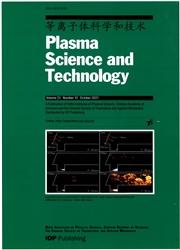基于改进电荷模型的短路电弧向二次电弧的时空演化
IF 1.8
3区 物理与天体物理
Q3 PHYSICS, FLUIDS & PLASMAS
引用次数: 0
摘要
二次电弧的初始形状对其后续形状影响很大。从理论上和实验上分析短路电弧向二次电弧的演变过程对于建立二次电弧形成时间模型和修改单相重合闸顺序至关重要。本文采用改进的电荷模拟方法建立了短路电弧的内部空间电场模型。用电场强度作为自变量来描述二次电弧的初始形状。在此基础上建立了二次电弧演化模型。并通过与物理实验结果的比较,对模型的精度进行了评价。当二次电弧电流增大时,电弧时间和色散增大。随着电弧时间的增加,电弧长度总体呈增加趋势。然而,由于电弧柱之间的短路,电弧点火时弧长会减少。在0°~ 90°范围内,随着风向与x轴夹角的增大,电弧时间减小。本文研究了短路电弧演变为二次电弧的方法。研究结果可用于建立二次电弧演化模型,为二次电弧抑制提供技术和理论依据。本文章由计算机程序翻译,如有差异,请以英文原文为准。
Spatiotemporal evolution of short-circuit arc to secondary arc based on the improved charge model
The initial shape of the secondary arc considerably influences its subsequent shape. To establish the model for the arcing time of the secondary arc and modify the single-phase reclosing sequence, theoretically and experimentally analyzing the evolution process of the short-circuit arc to the secondary arc is critical. In this study, an improved charge simulation method was used to develop the internal space electric field model of the short-circuit arc. The intensity of the electric field was used as an independent variable to describe the initial shape of the secondary arc. A secondary arc evolution model was developed based on this model. Moreover, the accuracy of the model was evaluated by comparing with physical experimental results. When the secondary arc current increased, the arcing time and dispersion increased. There is an overall trend of increasing arc length with increasing arcing time. Nevertheless, there is a reduction in arc length during arc ignition due to short circuits between the arc columns. Furthermore, the arcing time decreased in the range of 0°–90° as the angle between the wind direction and the x-axis increased. This study investigated the method by which short-circuit arcs evolve into secondary arcs. The results can be used to develop the secondary arc evolution model and provide both a technical and theoretical basis for secondary arc suppression.
求助全文
通过发布文献求助,成功后即可免费获取论文全文。
去求助
来源期刊

Plasma Science & Technology
物理-物理:流体与等离子体
CiteScore
3.10
自引率
11.80%
发文量
3773
审稿时长
3.8 months
期刊介绍:
PST assists in advancing plasma science and technology by reporting important, novel, helpful and thought-provoking progress in this strongly multidisciplinary and interdisciplinary field, in a timely manner.
A Publication of the Institute of Plasma Physics, Chinese Academy of Sciences and the Chinese Society of Theoretical and Applied Mechanics.
 求助内容:
求助内容: 应助结果提醒方式:
应助结果提醒方式:


